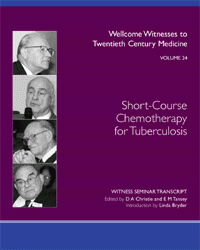Short-course Chemotherapy for Tuberculosis
 The introduction in 1952 of isoniazid established the standard treatment of streptomycin, isoniazid and either thiacetazone or para-aminosalicylic acid for pulmonary tuberculosis. To achieve good results, patients had to take treatment for 18 or even 24 months under supervision. By 1970 a move towards short-course chemotherapy was made, in part due to experimental work in mice at the Pasteur Institute (Paris) and in part to experiments in Professor Denny Mitchison's unit at the Hammersmith Hospital, along with the advent of rifampicin and reappraisal of pyrazinamide. Finally, a series of large controlled clinical trials were carried out by the MRC in East and Central Africa, India, Singapore, Hong Kong and elsewhere. The trials showed that a remarkable and quite unpredictable simplification of treatment could be made with a cost-benefit of major importance.
The introduction in 1952 of isoniazid established the standard treatment of streptomycin, isoniazid and either thiacetazone or para-aminosalicylic acid for pulmonary tuberculosis. To achieve good results, patients had to take treatment for 18 or even 24 months under supervision. By 1970 a move towards short-course chemotherapy was made, in part due to experimental work in mice at the Pasteur Institute (Paris) and in part to experiments in Professor Denny Mitchison's unit at the Hammersmith Hospital, along with the advent of rifampicin and reappraisal of pyrazinamide. Finally, a series of large controlled clinical trials were carried out by the MRC in East and Central Africa, India, Singapore, Hong Kong and elsewhere. The trials showed that a remarkable and quite unpredictable simplification of treatment could be made with a cost-benefit of major importance.
Chaired by Dr David Girling this Witness Seminar brought together a group of experts who were involved in some of the major developments in the treatment of tuberculosis and included: Dr Joseph Angel, Dr Ian Campbell, Sir Iain Chalmers, Dr Kenneth Citron, Sir John Crofton, Professor Janet Darbyshire, Professor Alan Glynn, Dr Tony Jenkins, Dr Amina Jindani, Dr Jeanette Meadway, Professor Denis Mitchison, Dr John Moore-Gillon, Professor Andrew Nunn, Professor Peter Ormerod and Dr Knut Øvreberg. Mrs Gaye Fox attended on behalf of Professor Wallace Fox.
Introduction by Dr Linda Bryder, 141 pp, 1 appendix, 2 figures, 2 tables, biographical notes, references, glossary and index.
Christie D A, Tansey E M. (eds) (2005) Short-course chemotherapy for tuberculosis, Wellcome Witnesses to Twentieth Century Medicine, vol. 24. London: The Wellcome Trust Centre for the History of Medicine at UCL.
ISBN 978 085484 1042




